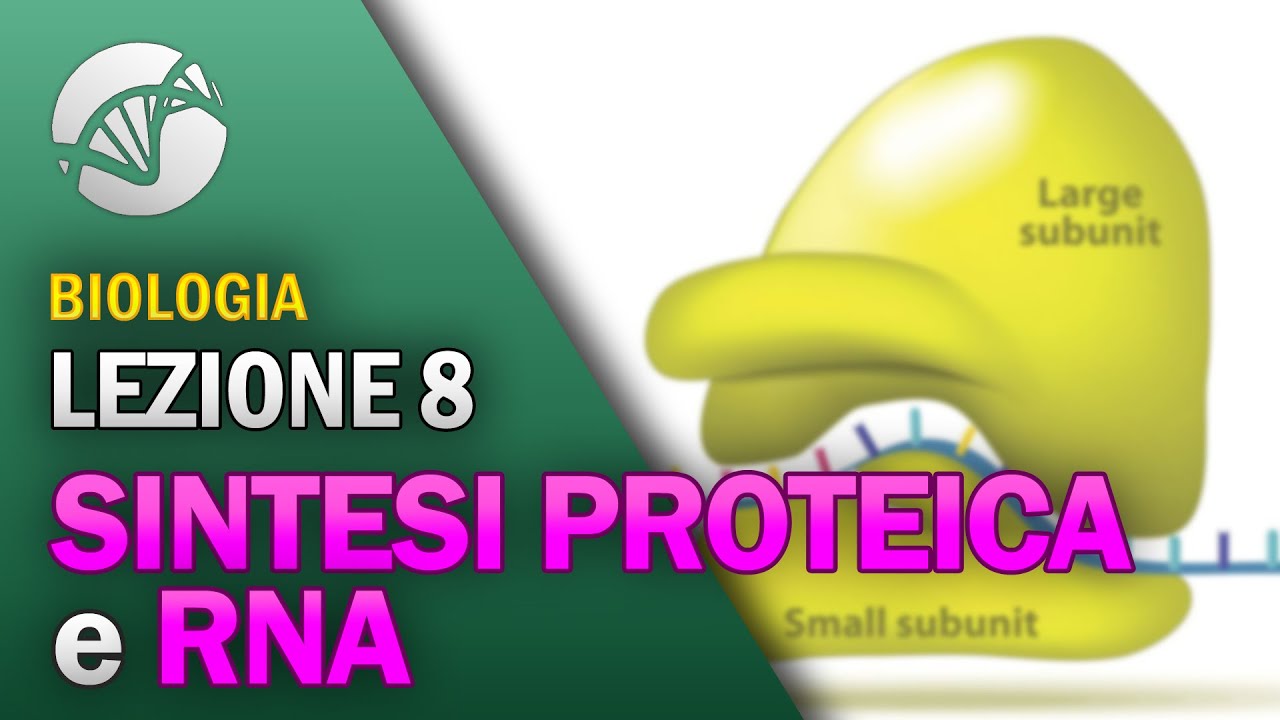La traduzione
Summary
TLDRTranslation is the second step in protein synthesis, where mRNA guides the formation of proteins. It occurs in the ribosomes, with tRNA transporting amino acids to form a polypeptide chain. The process involves mRNA, tRNA, ribosomes, and ATP. Translation starts when mRNA binds to the ribosome's minor subunit, and the tRNA reads the mRNA codons. Elongation follows as amino acids form peptide bonds, and termination occurs when the ribosome reaches a stop codon. The process involves precise interactions between codons, anticodons, and amino acids to produce functional proteins.
Takeaways
- 😀 Translation is the second step in protein synthesis, where mRNA guides the synthesis of proteins.
- 😀 mRNA transports genetic information from nuclear DNA to the ribosomes in the cytoplasm for translation.
- 😀 In eukaryotes, the initial mRNA (pre-mRNA) must undergo modifications to become active, mature mRNA before translation.
- 😀 tRNA is produced in the nucleus and transports amino acids to the ribosome, playing a crucial role in building the polypeptide chain.
- 😀 tRNA’s cloverleaf structure allows it to 'speak' both the language of nucleic acids and proteins, linking mRNA codons with specific amino acids.
- 😀 Ribosomes consist of two subunits: a minor subunit that binds mRNA and a major subunit that contains three sites (A, P, E) for tRNA interaction.
- 😀 Translation occurs in three phases: initiation, elongation, and termination.
- 😀 During initiation, the ribosome binds to the mRNA, and the start codon (AUG) is read by the tRNA's anticodon (UAC) to begin the process.
- 😀 In elongation, amino acids are joined to form a polypeptide chain, with peptide bonds linking amino acids from the P and A sites.
- 😀 Termination occurs when the ribosome encounters a stop codon, causing release factors to detach the polypeptide chain and end translation.
- 😀 The process of tRNA progression through the ribosome involves moving from the cytoplasm to the P site, the A site, and finally to the E site for release.
Q & A
What is translation in the context of protein synthesis?
-Translation is the second step in protein synthesis, where the mRNA produced during transcription guides the synthesis of proteins by linking the genetic information to amino acids.
Which molecules are involved in the translation process?
-The key molecules involved in translation are mRNA, tRNA, amino acids, and ATP.
What is the role of mRNA in translation?
-mRNA transports genetic information from nuclear DNA to the ribosomes in the cytoplasm, where it is used as a template for protein synthesis.
What happens to mRNA before it can participate in translation in eukaryotes?
-In eukaryotes, the initially generated mRNA is called pre-mRNA. It must undergo modifications to become mature mRNA before it can function in translation.
How does tRNA function in translation?
-tRNA transports specific amino acids to the ribosome by recognizing codons in the mRNA through its anticodon, facilitating the building of the polypeptide chain.
What is the structure of tRNA and how does it contribute to translation?
-tRNA has a cloverleaf structure that allows it to interact with both nucleic acids and proteins, reading the mRNA codons with its anticodon and carrying the corresponding amino acid.
What are the subunits of the ribosome, and what are their roles?
-Ribosomes have two subunits: the minor subunit, which binds mRNA, and the major subunit, which has three sites (A site, P site, and E site) that accommodate tRNA during translation.
What happens during the initiation phase of translation?
-During initiation, the mRNA binds to the minor ribosomal subunit in the cytoplasm. Translation begins when the ribosome reads the start codon (AUG) on the mRNA, and the corresponding tRNA anticodon (UAC) binds to the P site.
How does the elongation phase of translation work?
-In elongation, amino acids are added to the growing polypeptide chain. A peptide bond forms between the amino acids in the P site and A site, and the ribosome moves along the mRNA to the next codon.
What is the role of the ribosome during translation?
-The ribosome facilitates the process of translation by moving along the mRNA, providing sites for tRNA to bind, and catalyzing the formation of peptide bonds between amino acids.
What happens during the termination phase of translation?
-Termination occurs when the ribosome reaches a stop codon on the mRNA. Release factors bind to the ribosome, causing the release of the polypeptide chain and the separation of the ribosomal subunits.
How does tRNA cycle through the ribosome during translation?
-tRNA moves through the ribosome in a cycle: it enters the A site, moves to the P site where it contributes its amino acid to the chain, and then exits through the E site back into the cytoplasm.
Outlines

このセクションは有料ユーザー限定です。 アクセスするには、アップグレードをお願いします。
今すぐアップグレードMindmap

このセクションは有料ユーザー限定です。 アクセスするには、アップグレードをお願いします。
今すぐアップグレードKeywords

このセクションは有料ユーザー限定です。 アクセスするには、アップグレードをお願いします。
今すぐアップグレードHighlights

このセクションは有料ユーザー限定です。 アクセスするには、アップグレードをお願いします。
今すぐアップグレードTranscripts

このセクションは有料ユーザー限定です。 アクセスするには、アップグレードをお願いします。
今すぐアップグレード関連動画をさらに表示
5.0 / 5 (0 votes)






